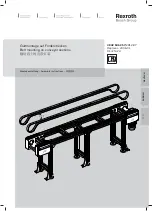
TROUBLESHOOTING AND REPAIR INSTRUCTIONS FOR L&L KILNS
troubleshoot-general.pdf
REV: 4/15/2017
Page 10
2017
L&L Kiln Mfg, Inc. 505 Sharptown Rd, Swedesboro NJ 08085 856.294.0077 F:856.294.0070 [email protected] hotkilns.com
KILN FIRES SLOWLY - BOTH SERIES
Run a Simple Paper Test
This will tell you if all kiln sections are firing. If they are not
it could be a bad relay or maybe a bad internal switch on
the control.
1. Place a little piece of paper in each element.
2. Then run a Fast Glaze (or turn the manual switches to
Hi on a manual kiln) while you watch the papers.
3. They begin to smolder in about 2 minutes. After 3 or 4
minutes shut the kiln off.
4. This shows you if the elements are operating (or which
ones are and which ones are not).
Bad or Wrong Voltage
1) Check your voltage. Do this at the kiln at the Power
Terminal Block with the control panel open or check it at
your fused disconnect box. CAUTION: This test should
only be done by an experienced person familiar with
electricity and its dangers. You need to see what the
voltage is when the kiln is firing. Low voltage will make the
kiln fire considerably slower. For instance a kiln designed
for 240 volts will have 25% less power when operated on
208 volts. Check voltage at your panel and where the kiln
is connected. Check the voltage when the kiln is firing and
when it is not firing. Sometimes the high amperage draw of
the kiln will cause a voltage drop at the kiln. A voltage drop
of 5 to 10 volts is not uncommon and is to be expected. If
your voltage drop is more than that then you may have a
problem with your electrical supply.
2) Make sure no other large electrical appliances such as a
clothes dryer or electric oven are on when you are operating
your kiln. This may cause a voltage drop which would slow
the kiln down.
3) Voltage may vary in your area depending on season and
time of day. Frequently there are “brown outs” during the
summer months in some areas. This is when the electric
utility reduces the voltage. Try firing at night after peak
electrical use hours. You can use your Delay feature to do
this easily. Find out from your local utility company when
the end of the peak period of electrical use is. Some utilities
offer preferential rates for using electricity at night because
it is cheaper for them.
4) Check to see what the wire size of your circuit is. If it is
very long (more than 50 feet) from your main circuit box
then the wire size might need to be higher (e.g. #8 instead
of #10 wire).
Element Aging
1) Elements both age and increase in resistance when fired.
When they increase in resistance the amount of power
they develop decreases. See the section on “CHECKING
ELEMENT RESISTANCE” at the end of this guide.
2) Replacing only one element per section or zone may
cause an unbalance in firing. In Easy-Fire kilns the multi-
zone control will compensate for much of this imbalance
automatically, however, this will not be the case in School-
Master kilns.
3) Use original L&L parts for satisfactory maintenance.
(Elements, in particular, provided by other vendors may not
work well in your L&L kiln. Some of our customers have
found this out the hard way and thought it was an L&L
problem. Only L&L has the design information to make our
elements properly).
4) Empty the kiln. Then turn kiln on until elements are red.
Open the door carefully and observe the elements to see
if they all seem to be glowing about the same amount.
CAUTION: The power does not turn off when you open
the lid. Be careful not to put your hand inside the kiln while
it is on. Dangerous electric shock could result. See the
diagnostic program described in the earlier section called
KILN FIRES UNEVENLY.
5) Elements expand and grow with age. If you fire low-fire
clay and glazes and never get above cone 05 or so, your
elements will last a long time, especially if you are only
bisque firing. This is good, to a point. If you only low-fire, the
problem you are most likely to encounter over many years is
that the elements will expand as they age. The length and
the coil diameter increase. Meanwhile the atmosphere in the
kiln slowly eats away at the metal of the element. Although
the total resistance usually increases as the elements age,
sometimes it decreases, or reverses itself. This usually only
happens when the elements are very old but have not yet
failed completely. As the element expands, it binds up in the
corners. This can make the individual coils push together
and touch each other in the corners, making a short cut for
the electricity, reducing the amount of element material the
electricity must pass through, and therefore reducing the
resistance in the whole element. This may make it hotter
in the kiln, but if there is a lot of element material jammed
in the corners there will not be enough material left in the
coiled form to radiate the heat generated by the increased
amperage and decreased resistance. Only the parts of the
wire not touching the coils on either side of them will emit
heat. More amperage through the electrical components in
the control could cause damage if the situation continues or
















































